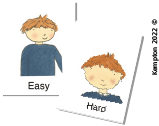Supporting children to recognise and talk about what they are good at, as well as what they find challenging, is important for self-esteem and can be an important step towards developing self-advocacy skills. Self-advocacy is a practical strategy that encourages people to identify and talk about their strengths and needs, as well as developing the confidence to ask for help. Pocock et al. (2002) suggests that promoting self-advocacy in children and young people with learning needs can support self-confidence and independence.
In my clinical work I see that many children with DLD are aware of their communication differences. It is important that we listen to their views and feelings about their communication. I believe that making time for these conversations can help children to feel listened to and understood. It also encourages me to see beyond a child’s difficulties and work in a more holistic and child-centred way.
When I started writing the picture book Harry’s Story, I wanted to help raise awareness of DLD and create a character that some children with DLD may identify with. Harry shows us some of the challenges he experiences at school, but we also see his strengths and skills. As the picture book and user guide developed, I saw that Harry’s Story could be used as a springboard to support conversations with children about their own strengths and differences.
Here are some things to consider when talking about strengths, needs and differences:
Ready or not?
Respecting your child’s readiness to communicate their own thoughts and feelings is important. Some children with DLD may not be aware of, or ready to talk about, their differences with communication just yet and this is OK.
Talking with others
Encourage your child to talk to different people about what they like, what they are good at, and what they need help with. This supports children to see that we all need help sometimes and we are all good at different things.
Who helps you?
Talk to children about the different places they visit in the week. Talk about what they need help with there and who helps them e.g., at swim club, the swim teacher helps them remember what to do in the pool.
Small group work
Support children to work with a partner or a small group to identify a character’s strengths and needs. This can be done using a picture book; encourage the children to notice what the main character is good at and what they need help with.
Use visual supports
Sort picture symbols or written phrases into groups and explore what children Like & Don’t Like, or what they find Easy & Hard. Aim to include a variety of activities, such as playing football/writing stories/making my friends laugh.
You might notice that some children create their own central pile, to show activities that lie ‘in the middle’.

To find out more about how you can support your pupils with DLD, Kate’s new Book: Supporting Children with DLD: A picture book and user guide to learn about DLD, is available from Routledge
Top Tips
Tops tips for talking to children with DLD (extract from Supporting Children with DLD):
Know how the child communicates
If you are not the child’s parent, make sure you know them well and how they communicate. For example, if you know the child likes to use picture symbols or photographs to help them communicate make sure these are available for them to use. You will both get a lot more out of the conversation if the child trusts you and feels relaxed talking to you.
Take time
Be patient and give your child plenty of time to think and respond. It often takes children with DLD longer to understand and respond to what has been said, so it’s important they don’t feel rushed. Slowing down your own talking, and taking time to pause in conversation, can make a positive difference.
Use simple language
Children with DLD often struggle with grammar and complicated sentence structures. It is important to simplify your own language to help your child understand what you are saying. Try to use words that the child is familiar with and keep your sentences short and simple.
Listen
Listen to what the child is telling you and try hard not to interrupt or ask leading questions. You could occasionally repeat back what the child has said, to show them you have listened and understood.
References
- Pocock A, Lambros S, Karvonen M, et al. (2002). Successful Strategies for Promoting Self-Advocacy Among Students with LD: The LEAD Group.
- Intervention in School and Clinic. 37(4):209-216.
Please login to view this content
Login